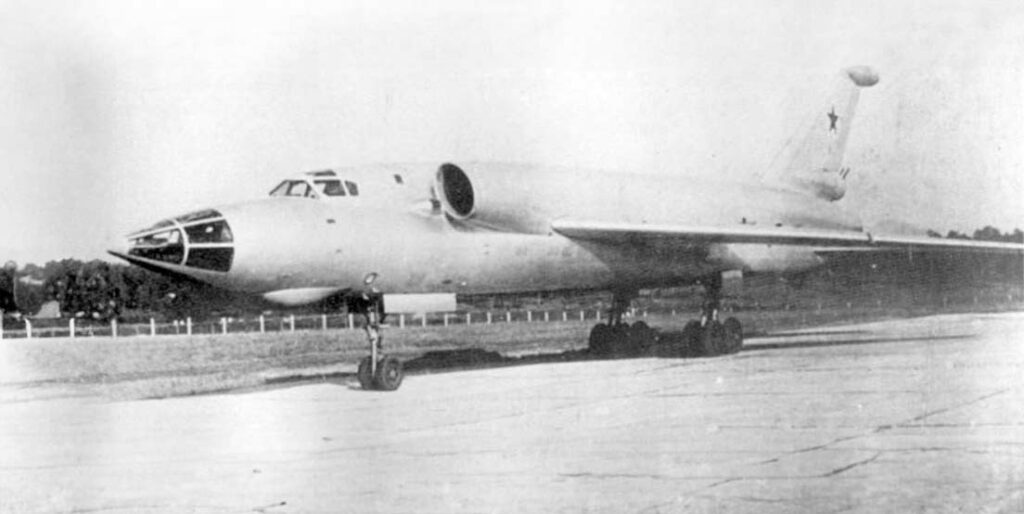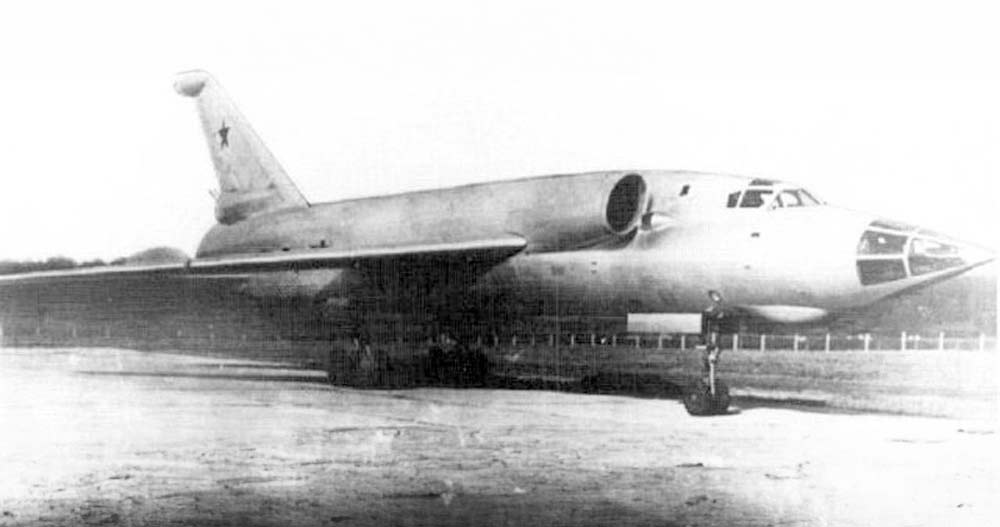The Tupolev Tu-98 “Backfin” was a prototype Soviet swept-wing jet bomber with afterburning engines, developed in the 1950s.
In brief
The Tupolev Tu-98, known as “Backfin” in NATO terminology, was a Soviet experimental bomber aircraft developed in the 1950s. It was a prototype for a fast supersonic bomber intended to replace the Tupolev Tu-16. Featuring a swept wing design, the Tu-98 was powered by two Lyulka AL-7 turbojet engines and had a top speed of 768 mph. Despite its innovative design, the Tu-98 never advanced beyond the prototype stage, with only one unit built. However, its design and technology significantly influenced subsequent Soviet aircraft, such as the Tupolev Tu-22 and Tu-128.
The Tupolev Tu-98 “Backfin” was a notable attempt by the Soviet Union to develop a supersonic bomber during the Cold War.

History of Development
In the context of the Cold War, the Soviet Union sought to advance its military aviation technology, specifically to develop a supersonic bomber capable of replacing the Tupolev Tu-16. The Tupolev Tu-98, under the leadership of chief designer Dmitri Markov, emerged from this ambitious goal.
The development of the Tu-98 began in the early 1950s, with an official basis for the work established by a Resolution of the Council of Ministers of the USSR in December 1952. Tupolev’s design aimed to create a fast bomber with superior performance compared to existing Soviet bombers. The Tu-98 was seen as an important strategic asset to counter the Western military capabilities, particularly those of the United States and NATO allies.
The first and only prototype of the Tu-98 was completed in 1956, with its first flight occurring in the spring of that year. The project faced several challenges, including delays due to the development of the Lyulka AL-7 engines. Despite its promising design, the Tu-98 never entered serial production, and the program was eventually disbanded. The experience gained from the Tu-98 project, however, was instrumental in the development of future Soviet aircraft, including the Tu-28 interceptor and the Tu-22 bomber.
Design
The Tupolev Tu-98 featured a swept wing design based on the earlier Tu-16 but with significant improvements. The aircraft’s engines, two Lyulka AL-7Fs, were placed in the fuselage with large air intakes located behind and on either side of the cockpit. These engines were capable of producing 10,000 kg of static thrust and were fitted with afterburners, giving the aircraft the necessary power to break the sound barrier.
The Tu-98’s design also included advanced features like rocket-bomb armament, capable of carrying a range of explosive ordnance, including FAB-100, FAB-250, and FAB-500 bombs, in various combinations. For naval aviation, the aircraft could be armed with AMD-500 and AMD-100 mines, torpedoes RAT-52, MAN, MAV, and TAN-53.
The aircraft’s sighting equipment included the “Initiative” radar and the OPB-16 collimator sight, allowing for precise targeting. The Tu-98 had a wingspan of 17.27 meters, a length of 32.06 meters, and a height of 8.06 meters. Its wing area was 87.50 square meters, and it had a maximum takeoff weight of 39,000 kg.
Performance
The Tupolev Tu-98’s performance was impressive for its time, with a maximum speed of 1238 km/h (769 mph) and a practical ceiling of 12,750 meters (41,831 feet). It had a range of 2440 km (1,516 miles). The aircraft’s speed and altitude capabilities were enhanced by its powerful AL-7F turbofan engines, which produced a thrust of 6850-8000 kg each.
Compared to other bombers of the era, the Tu-98’s performance was noteworthy, particularly in terms of its supersonic speed capabilities. However, its range and payload capacity were limited compared to larger strategic bombers. The Tu-98’s design and performance were influential in the development of subsequent Soviet aircraft, particularly in the field of supersonic aviation.
Variants of the Tupolev Tu-98
The Tupolev Tu-98 “Backfin” was produced as a single prototype and did not have any other variants. The prototype itself was a significant step in Soviet bomber design, combining advanced aerodynamics with powerful turbojet engines.
Although the Tu-98 did not lead to a production series, its design and technological advancements were utilized in the development of other aircraft. The experience gained from the Tu-98 project contributed to the creation of the Tupolev Tu-22 and Tu-128, which became important aircraft in the Soviet military aviation arsenal.

Military use and combat of the Tupolev Tu-98
The Tupolev Tu-98 “Backfin” did not see military use or combat as it remained a prototype and was not adopted into service by the Soviet Air Force. Its primary role was as a technological demonstrator and a testbed for new concepts in supersonic bomber design.
The Tu-98’s development was part of the Soviet Union’s broader efforts to advance its military aviation capabilities during the Cold War. While the aircraft itself did not enter service, the knowledge and experience gained from the Tu-98 were valuable in the subsequent development of Soviet military aircraft.
The Tu-98 was a testament to the Soviet Union’s commitment to innovation in military aviation, despite the challenges and limitations faced during its development. Its influence on future aircraft designs demonstrated the importance of experimental and prototype aircraft in advancing aerospace technology.
The Tupolev Tu-98 “Backfin” was a significant milestone in Soviet aviation history, representing a bold attempt to develop a supersonic bomber during the Cold War. While the aircraft never advanced beyond the prototype stage, its design and performance had a lasting impact on Soviet military aviation. The Tu-98’s legacy lies in its contribution to the development of future aircraft and the progression of supersonic aviation technology in the Soviet Union.
Back to the experimental aircraft section.